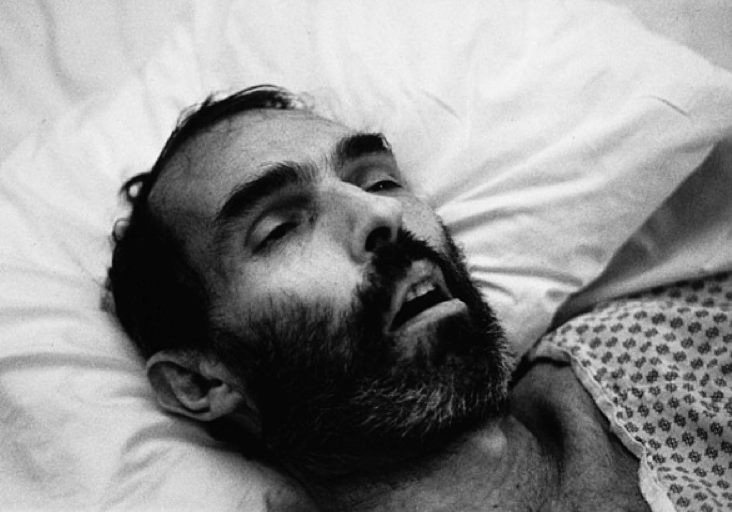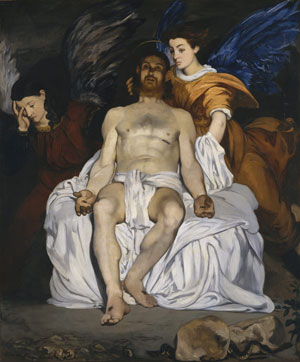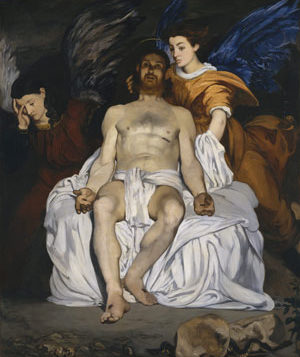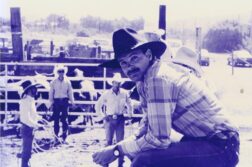A few weeks ago I visited the exhibition The Unflinching Eye at Mamdouha Bobst Gallery at NYU and a massive collection of work by David Wojnarowicz. The exhibit contained paintings, ephemera, drawings and photographs including Wojnarowicz’ photograph of Peter Hujar, in a hospital bed, as he succumbed to his death from AIDS. In the photograph suffering had conquered every aspect of his flesh and soul.

The face and eyes of Hujar as he lay dying consumed me. I’d seen the look on Hujar’s face many gut-wrenching, heartbroken times. The same look existed on the faces of so many friends who were ravaged by AIDS and whose loss is awakened every Christmas when their cards are no longer sent or received.
I wonder sometimes if anything can shock young people these days. At the risk of dating myself, I refer to the generation that would be my generation’s grand-children. Today’s youth, probably more than any other generation, is image-oriented, photo-driven; most of life is viewed on a screen.
Youth is a time to explore. It also is a time when people take risks, make mistakes and if they’re lucky or wise they also seek information about life.
Maybe it is inevitable, but each generation tends to feel somewhat invincible, and this reality today can carry over to what was referred to as the plague of the 1980s, the unreal reality of AIDS and its aftermath, and especially its impact on my own generation. I lost 23 friends. Most of them, if not all, were involved in the arts in some aspect, as writers, actors, dancers, and designers.
According to the CDC, 26 percent of the 50,000 Americans infected each year with HIV today are under the age of 25. That’s just over 1,000 new infections every month. Sixty percent of them are unaware of their status and may unknowingly pass the virus on to others. Fear of stigma also plays a role, and the resulting silence.

There’s a painting at the Metropolitan Museum of Art in New York, The Dead Christ with Angels, by Édouard Manet. It’s a highly realistic oil painting of a crucified Christ figure surrounded by devoted, compassionate angels. The work is beautiful, haunting, and tragic. The figures reminded me of a family, of friends and caretakers, and of the friends I lost during the 1980s and AIDS as it swept through the artistic community in New York City. The image in the painting is, in its own way, another image of that devastation, an illustration of the impact of AIDS.
The face of a man in the last hours of AIDS, captured and documented in Hujar’s image, and in the glass library case that afternoon, is the same tortured face of the crucifixion. The body is spent. The mind is spent. The face is becoming a skull and Wojnarowicz’ photograph captured that moment. The photograph of Hujar was taken just moments before the face turned into its skull. It is a haunting, crushing moment.
For a new generation today who may wonder what the plague of my generation looked like, it was those images multiplied over and over a thousand times, in what seemed like a matter of days. The deaths seemed hourly, like war.
I’ve written about AIDS on several occasions. I’ve created collages and drawings including a black-and-white drawing called “They Asked Me to Say a Few Words about Losing So Many to AIDS: The Skulls Follow Me Wherever I Go Now.”
Sitting by the bedside of someone in the last months of AIDS during the 1980s was like watching clouds over the sun. You waited for the clouds to pass. Sometimes it was overcast for weeks. Then one day, like a miracle, there was sunshine and things were clear, normal, and the way they used to be, for a moment. But most of the time was spent waiting. Beneath the layers of blanket was a person who once shared your hopes and dreams. Beneath all that cloud, the old familiar person still existed. Beneath the swelling and bruises and sores was someone you loved. But it was all concealed. Changed by tubing, dementia, adult sized diapers and food that didn’t require chewing. Blinking metal boxes were attached through wires to a leg or arm. Those machines embraced the body now the way a friend or lover once did. But the feel was metallic. It gave the body no warmth. And this is what the person in the last weeks of AIDS needs. Body heat. To be held. To be whispered to. Sung to. Read to. The machines and tubes and plastic sheets and tissues for everyone’s tears, are all part of the final moments. A Rolex ticking on bone.
I wonder what my playwright friends would be writing today; whose work would be on Broadway, Off Broadway; whose paintings would be in a gallery, and what would they be painting, designing, writing about. The loss of the artistic voices of my generation are being felt in a very personal way as we age, and the thoughts of the legacies that were denied a chance to exist. One of the artistic voices of my generation lost to AIDS was the artist Ken Burgess.* Kenny was a dear friend for two decades, my colleague at the Caffe Cino – the cradle of gay culture, and my art mentor.
The two masterpieces, one old and one modern, Manet’s Christ and Wojnarowicz’ Hujar, offer a glimpse of the face of AIDS for those without any reference points. They offer an image for a new image driven generation.
According to a recent CDC study, few of the young people surveyed ever engaged in discussions about HIV/AIDS with their sexual partner, despite the fact that more than 75 percent said that they want more information. For an image driven generation, studying the images by Manet and Wojnarowicz may be a good place to begin.

“Magic Time!—Art & Ephemera of the Caffé Cino” will open on August 15 at ClampArt in NYC and run through September 28. The gallery exhibit will include the work of Magie Dominic, Kenny Burgess (colleague of Magie Dominic and lost to AIDS), and ephemera from the Caffe Cino where both Burgess and Dominic worked. For more info, email: info@clampart.com or visit ClampArt.
Magie Dominic, a Newfoundland- and New York-based writer and artist, is the author of the memoirs The Queen of Peace Room (2002) and its sequel Street Angel (2014).






